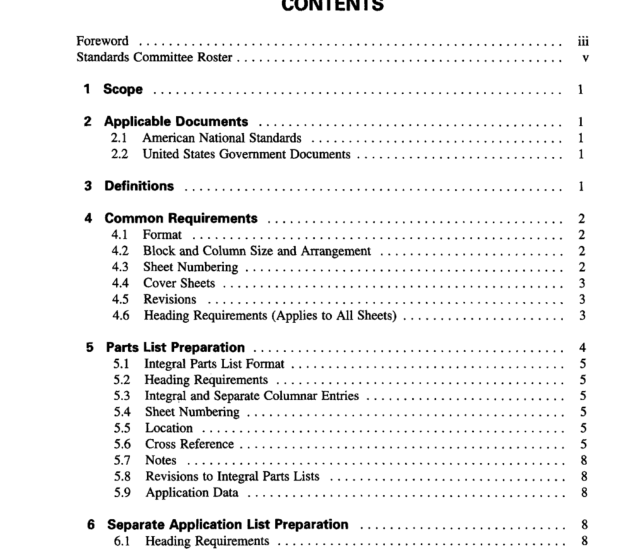ASME Y14.34M:1996 pdf download ASSOCIATED LISTS
1 scOPE
This Standard establishes the minimum requirementsfor the preparation and revision of parts lists,applicationlists, data lists, and index lists. In addition, this Standardpresents certain options that may be incorporated intoparts lists, data lists,index lists,application lists,inden-tured data lists, and wire lists at the discretion of the de-sign activity.
2 APPLICABLE DOCUMENTs
When the following American National Standards re-ferred to in this Standard are superseded by a revisionapproved by the American National Standards Institute,the revision shall apply.
2.1 American National Standards
ASME Y14.1-1995,Decimal Inch Drawing Sheet Sizeand Format
ASME Y14.1M-1995,Metric Drawing Sheet Size andFormat
ASME Y14.2M,Line Conventions and Lettering
ASME Y14.35M-1997,Revision ofEngineeringDrawings and Associated Documents
IEEE 200-1975 (R1989)(ANSI Y32.16-1975),Refer-ence Designations for Electrical and Electronic Partsand Equipment
2.2 United States Government DocumentsCataloging Handbook H4/H8,Commercial andGovernment Entity (CAGE)
3 DEFINITIONS
alphanrumeric arrangement: for a designation in a list, agrouping of mixed symbols, numbers, and letters used toform the designation.These are arranged so that the firstcharacter in the designation aligns in the furthest leftmostposition in the column. For each designation in the col-umn, the first position characters are arranged by sym-
bols,e.g.,a dash symbol, then numerically, then alpha-betically, as applicable. Succeeding characters in the sec-ond position (and subsequent positions) are next arrangedby symbol,then numerically,then alphabetically in thesame manner as the first position. Designations composedonly of single characters shall be arranged first within acolumn list, followed by those with a dash in the secondcharacter position. Next,after the dash second characterposition, shall come the numerical second position char-acters, then the alphabetical second position characters.These procedures are applicable for all remaining char-acter positions within designations.
application data: the next assembly(ies), and the modelnumber, nomenclature, or equivalent designator of the as-sembled unit(s), of which a part or assembly is a com-ponent.
application list (AL): application data presented in a sep-arate list. See Fig. 13.
approval: an indication that the document meets generalrequirements for preparation and content. An entry doesnot indicate approval of the design depicted on the re-lated drawing.
bulk items: constituents of an assembly or part, such as oil,wax,cement,ink.grease,flux,welding rod,twine,orchain, that satisfies one or more of the following criteria:(a) the quantity is not readily predetermined;
b) the physical nature of the material is such that itis not adaptable to pictorial representation;
(c) the finished size is obtainable through use of suchtools,such as shears,pliers,or knives,without furthermachining operation, and the final configuration is suchthat it can be described in writing without the necessityof pictorial representation.
CAGE Code(Commercial and Government Entity Code):a code assigned by the government to identify a firmwhich designs, manufactures, or supplies items.
data list (DL): a tabulation of all engineering drawings,associated lists,specifications, standards, and subordinatedata lists pertaining to the item to which the data list applies and essential in-house documents necessary to meetthe technical design disclosure requirements except forthose in-house documents referenced parenthetically. SeeFigs. 11A and 11B.
design activity: an activity having,or having had,re-sponsibility for the design of an item. The activity maybe a government activity or a contractor, vendor, or other.design activiry,current: an activity currently having re-sponsibility for the design of an item,and the prepara-tion and maintenance of the drawings and associated doc-uments. Current design activity could be the originaldesign activity or new activity when that responsibilityis transferred from another design activity.
design activity,original: an activity that initially had re-sponsibility for the design of an item and the preparationand maintenance of the drawings and associated documents.digital data: data created and stored on a computer sys-tem which employs a display on which the user and thecomputer interact to create entities for producing layouts,drawings,numerical control tapes,disks,or other engi-neering data.
find ruanber or item number: a reference number assignedto designate an item on the field of the drawing in lieu ofusing the item’s part or identifying number. It is entered asa cross reference to the line of the parts list where the item’sactual part or identifying number and description are given.Reference designations in accordance with IEEE200(ANSIY32.16) may be used as find numbers or item nurmbers.flag note: a note whose text is prefixed by a note identi-fication enclosed within a symbol (flag). The note is crossreferenced to a specific area on a drawing, or associatedlist, by entering the flag at the point of application.identification cross reference drawing: an administrativetype drawing which assigns unique identifiers to providea cross reference to the original incompatible identifiers.indentured data list (ID): a data list showing the docu-ments for a complete system or end item in a top-down(generation tree) order. See Figs. 8A and 8B.
index list (L) a tabulation of data lists and subordinateindex lists pertaining to the item to which the index listapplies. See Fig.12.
item: a nonspecific term used to denote any unit or prod-uct,such as a part,material,assembly,equipment,ac-cessory, or attachment.
